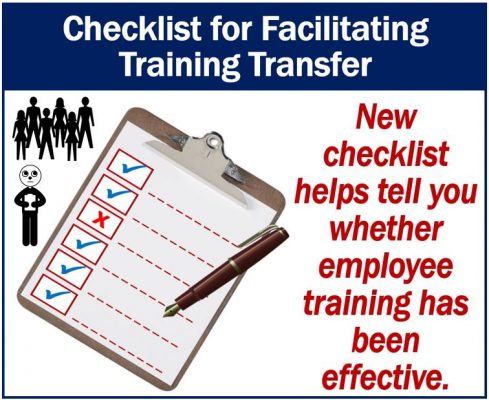A new checklist can help trainers and managers determine whether employee training has been effective. Businesses and other organizations spend billions of dollars annually on employee training. Being able to tell how effective specific training measures have been has always been a challenge. Researchers at Rice University and the University of Illinois at Chicago (UIC) have created a checklist. Managers, assessors, and trainers can use it when developing, implementing, and evaluating employee training courses and programs.
Ashley M Hughes, Stephanie Zajac, Jacqueline M Spencer, and Eduardo Salas wrote about their checklist in the International Journal of Training and Development (citation below).
The authors say that their list provides practical guidance for every stage of implementing training programs.
They developed the checklist by gathering and analyzing data from scientific research on learning and organizational training. They then figured out the best ways to achieve ‘training transfer.’ According to a Rice University press release, training transfer is the “translation of knowledge to skills for better performance.”
Ashley Hughes, an Assistant Professor of Biomedical and Health Information Sciences at UIC, said:
“Training transfer is vital across all industries, but among health care organizations the stakes are arguably higher.”

Checklist – translating the science into a practice tool
Eduardo Salas, Chair of and Professor of Rice University’s Department of Psychological Sciences, said:
“There is a science of training and, surprisingly, most organizations are not aware of it or ignore it. This checklist is an attempt to translate the science into a practical tool.”
The authors divided the checklist into three ‘yes’ and ‘no’ sections. The trainer, supervisor, HR manager, or assessor goes through them before, during, and after employees undergo training.
HR stands for Human Resources, a department or organization that trains, hires, and administers the workforce.
Checklist – ‘Before’ section
This section tells you whether the training program will meet the needs of the organization or company. It asks questions like:
- “Has the facility identified which employees will attend the training.”
- “Are there policies and procedures in place to support training?”
Checklist – ‘During’ section
The ‘During’ section is all about the training’s content. It asks questions like:
- “Are trainees provided opportunities to actively participate during training?”
- “Was the training developed using a valid training strategy and design?”
Checklist – ‘After’ section
These questions can be asked several times. They check whether employees remember what they learned. It also determines whether they need more help. Below are two examples of the questions in this section:
- “Are managers provided with tools and advice to support the use of learned knowledge and skills on the job?”
- “Does the evaluation reveal that the training should be adapted?”
The authors hope that their checklist will help make sure that the skills, knowledge, and attitudes that employees learned in training will improve their job performance.
Prof. Hughes said:
“We believe the checklist will eliminate unnecessary training, enable more motivated, engaged and effective staff and possibly serve as a gateway for cultural change within an organization.”
Citation
“A checklist for facilitating training transfer in organizations,” Ashley M Hughes, Stephanie Zajac, Jacqueline M Spencer, and Eduardo Salas. International Journal of Training and Development, November 2018. DOI: https://doi.org/10.1111/ijtd.12141.

